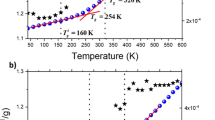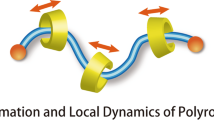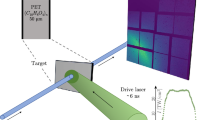Abstract
SEMI-CRYSTALLINE polymers, according to the current twophase model, consist of an impermeable, denser crystalline phase (the lamellae) and a permeable, less dense amorphous phase (the interlamellar regions)1. All permeation and transport properties occur predominantly in the latter, and are a function of the overall amorphous fraction within the bulk and the geometry of the crystallites embedded in the amorphous phase. For linear polyethylene cooled at various rates from the melt, the diffusion coefficient D of gaseous diffusants varies2,3 according to where x is the corresponding crystalline volume fraction, and (1−x) the amorphicity. The diffusional behaviour of long chain diffusants, however, may be very different. For example, it has been suggested4 that the transport of long chain molecules through the disordered interlamellar regions of polythene will be greatly influenced by the presence of interlamellar tie-molecules and entanglements. These are relatively immobile features in the disordered region which can obstruct the movement of long chain molecules, but not that of smaller (for example, gaseous) diffusants if their size is less than the separation between these features. An extension of de Gennes ideas on reptation5 gives a semiquantitative relation for the diffusion coefficient of long molecules in polyethylene: long molecules should diffuse faster in slowly cooled than in quenched polyethylene, in spite of the higher disordered fraction in the latter and in marked contrast to the behaviour of gaseous or light vapour diffusants, because rapid cooling results in a greater profusion of fixed tie-molecules6, which constrain long diffusants but have little effect on small ones. We report here results which support this model.
where x is the corresponding crystalline volume fraction, and (1−x) the amorphicity. The diffusional behaviour of long chain diffusants, however, may be very different. For example, it has been suggested4 that the transport of long chain molecules through the disordered interlamellar regions of polythene will be greatly influenced by the presence of interlamellar tie-molecules and entanglements. These are relatively immobile features in the disordered region which can obstruct the movement of long chain molecules, but not that of smaller (for example, gaseous) diffusants if their size is less than the separation between these features. An extension of de Gennes ideas on reptation5 gives a semiquantitative relation for the diffusion coefficient of long molecules in polyethylene: long molecules should diffuse faster in slowly cooled than in quenched polyethylene, in spite of the higher disordered fraction in the latter and in marked contrast to the behaviour of gaseous or light vapour diffusants, because rapid cooling results in a greater profusion of fixed tie-molecules6, which constrain long diffusants but have little effect on small ones. We report here results which support this model.
This is a preview of subscription content, access via your institution
Access options
Subscribe to this journal
Receive 51 print issues and online access
$199.00 per year
only $3.90 per issue
Buy this article
- Purchase on Springer Link
- Instant access to full article PDF
Prices may be subject to local taxes which are calculated during checkout
Similar content being viewed by others
References
Crank, J. & Park, G. S. eds Diffusion in Polymers (Academic, New York, 1968).
Michaels, A. S., Bixler, H. J. & Fein, H. L. J. appl. Phys. 35, 3165 (1964).
Eby, R. K. J. appl. Phys. 35, 2720 (1964).
Klein, J. J. Polym. Sci. Polym. Phys. Edn (in the press).
de Gennes, P. G. J. chem. Phys. 55, 572 (1971).
Peterlin, A. Proc. IUPAC Symp. Macromolecules, Aberdeen 1973, 239–264 (Butterworths, London, 1974).
Klein, J. & Briscoe, B. J. Nature 257. 386 (1975); Klein, J. & Briscoe, B. J. Polymer 17, 481 (1976).
Klein, J. & Briscoe, B. J. J. Polym. Sci. Polym. Phys. Edn (in the press).
Author information
Authors and Affiliations
Rights and permissions
About this article
Cite this article
KLEIN, J., BRISCOE, B. The behaviour of long molecules diffusing in solid polyethylene. Nature 266, 43–44 (1977). https://doi.org/10.1038/266043a0
Received:
Accepted:
Published:
Issue Date:
DOI: https://doi.org/10.1038/266043a0
Comments
By submitting a comment you agree to abide by our Terms and Community Guidelines. If you find something abusive or that does not comply with our terms or guidelines please flag it as inappropriate.



